
by Judy Biss | Feb 7, 2014
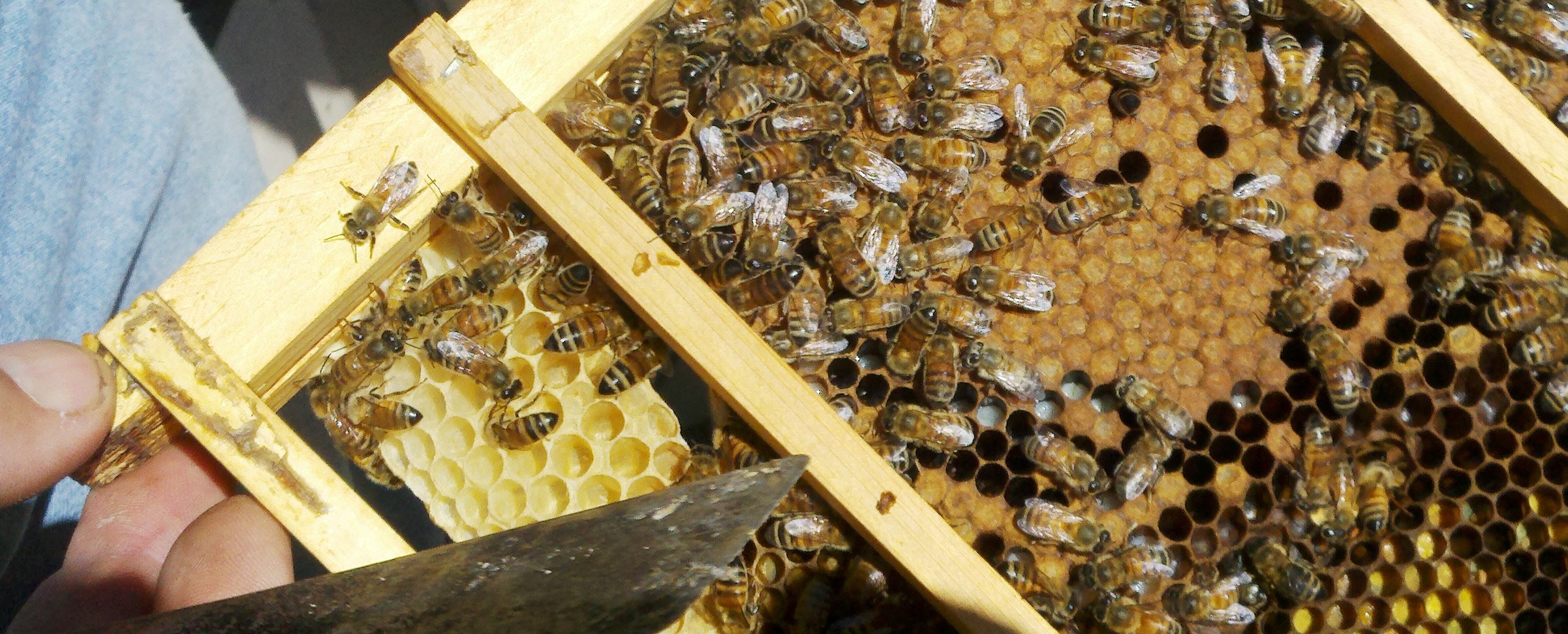
Photo by Judy Ludlow
The UF/IFAS Panhandle Agriculture Extension Team will once again be offering a Basic Beekeeping School in February and March. These classes will be offered via interactive video conferencing at Extension Offices across the Panhandle. Details are listed below, please call your local UF/IFAS Extension Service to register and if you have any questions. See you there!
- These classes will be taught by Dr. Jamie Ellis and other state and nationally recognized beekeeping experts from the University of Florida Honey Bee Research and Extension Lab and the Florida Department of Agriculture & Consumer Services Bureau of Plant and Apiary Inspection.
- There will be three Monday-evening and one Tuesday evening interactive video conferences from 6:00 – 8:00 pm Central time, (7-9 pm Eastern time) and a Saturday bee-yard field day.
- Each 30-50 minute presentation will be followed by a question/answer period
February 24: Honey Bee Biology and Anatomy
March 3: Varroa Mite Biology and Control
March 10: Honey Bees of the World and Beekeeping History
March 15: Bee-Yard Field-Day – A hands on teaching opportunity
March 18: Yearly Management of the honey bee
- The cost for all five classes is $25 per person or $40 for a family. This fee will cover course materials and refreshments.
- Deadline to register is February 17, 2014. Please contact your local UF IFAS Extension office to register or to find out more details, or click on the following link for a printer-friendly flyer: 2014 Beekeeping in Panhandle
Bay County 850-784-6105
Calhoun County 850-674-8323
Escambia County 850-475-5230
Franklin County 850-653-9337
Gadsden County 850-875-7255
Gulf County 850-639-3200
Holmes County 850-547-1108
Jackson County 850-482-9620
Jefferson County 850-342-0187
Leon County 850-606-5202
Liberty County 850-643-2229
Okaloosa County 850-689-5850
Santa Rosa County 850-623-3868
Wakulla County 850-926-3931
Walton County 850-892-8172
Washington County 850-638-6180
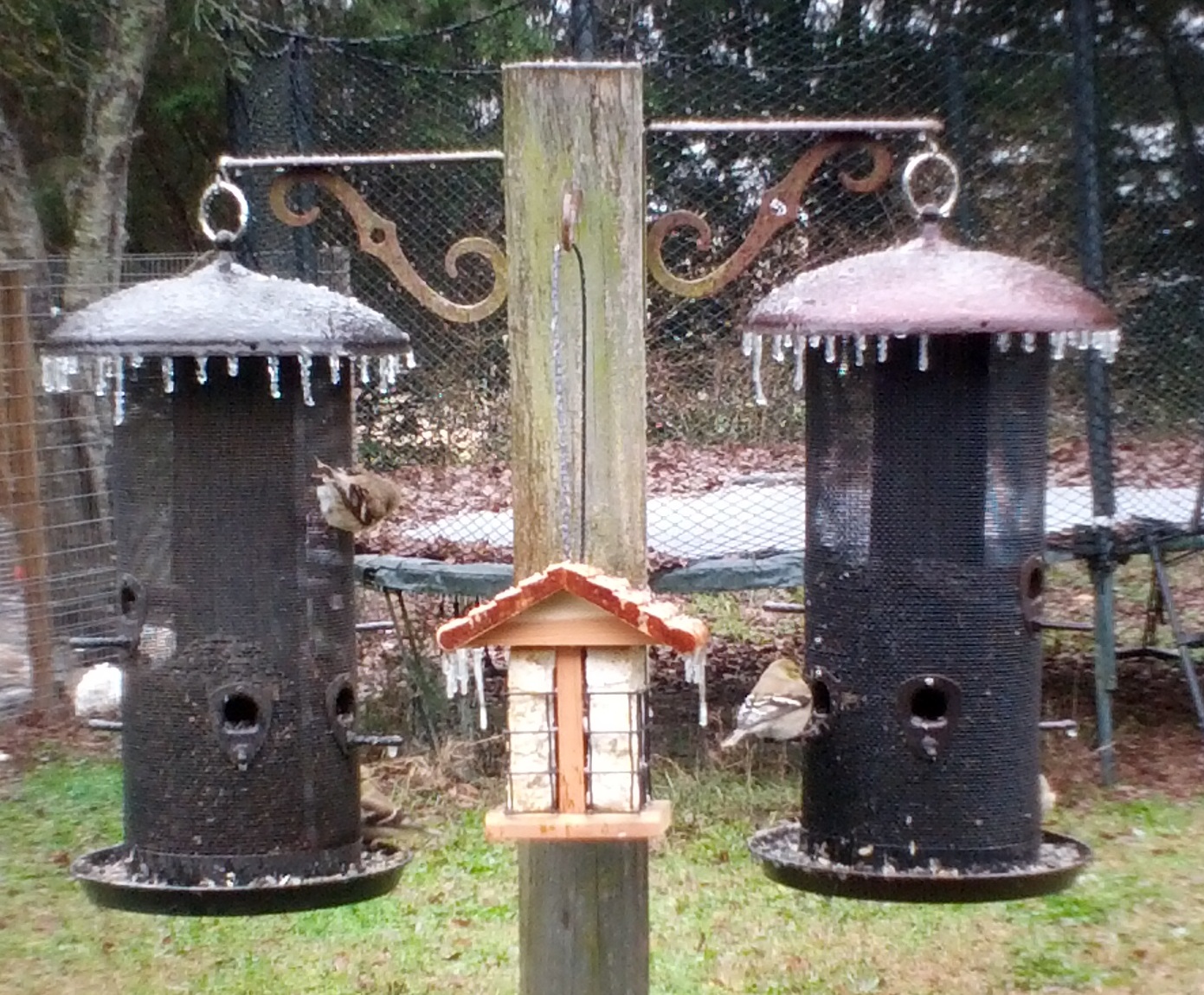
by Judy Biss | Feb 2, 2014

Even though adapted to weather extremes, these migratory American goldfinches (Spinus tristis) appreciated the food and cover provided in this backyard. Photo by Judy Ludlow
North Florida experienced a weather delight (or distress depending on your point of view!) this week in the form of freezing rain and snow! The words “Florida” and “snow” are two words most people would not place together in the same sentence, but you may be surprised to learn that snow has been documented a number of times in Florida as revealed by records as early as 1891. In Tallahassee, measurable snow has not fallen since 1989.
The following information is taken from the National Weather Service Weather Forecast Office Tallahassee, FL about the history of Snowfall in Tallahassee: Several winters ago, NWS Tallahassee Climate Focal Point, Tim Barry, responded to an inquiry from a reporter concerning snow climatology in Tallahassee. Some of those questions and answers are listed below.
In ten-year intervals, how many times has it snowed in Tallahassee Florida?
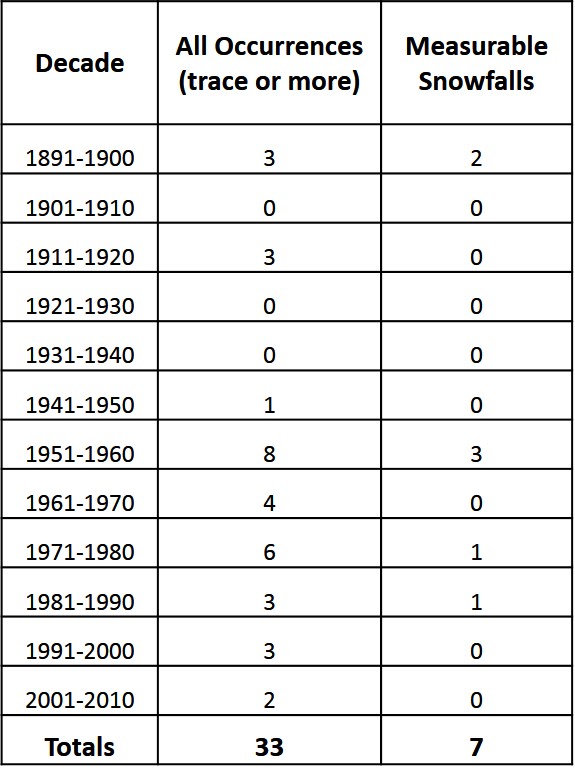 How frequently does Tallahassee see snowfall?
How frequently does Tallahassee see snowfall?
From the information provided in the 1st question, we see that it snowed 32 times in Tallahassee since 1891. Please note that all but 7 of these occurrences were only Trace amounts. If we were to divide the period of record (117 years) by 32 we would get a frequency of once every 3.66 years. But as you can see from above, the more frequent occurrences of snow in the 50’s ,60’s and 70’s have skewed the results. The return period for measurable snow is just once every 17 years. The most snow recorded in a 24-hour period was 2.8″ from February 12th – 13th, 1958.
Any interesting or exciting facts about Tallahassee winters?
There is a significant difference between the climate of north Florida and the southern portions of the peninsula. On average, we experience 35 days with minimum temperatures at or below freezing with most of these occurring from December through March. The coldest temperature ever recorded in Tallahassee was -2 F on February 13th 1899. More recently, we dipped down to 6 degrees F on January 21st, 1985.
Florida’s wildlife, although adapted to Florida’s weather, will thrive given the added boost of backyard habitats planned for their benefit, especially during these winter weather extremes! During the winter, Florida’s native, resident, wildlife species are also joined by species which are here temporarily as they migrate through our state. The hundreds of American goldfinches (Spinus tristis) outside my window are one example.
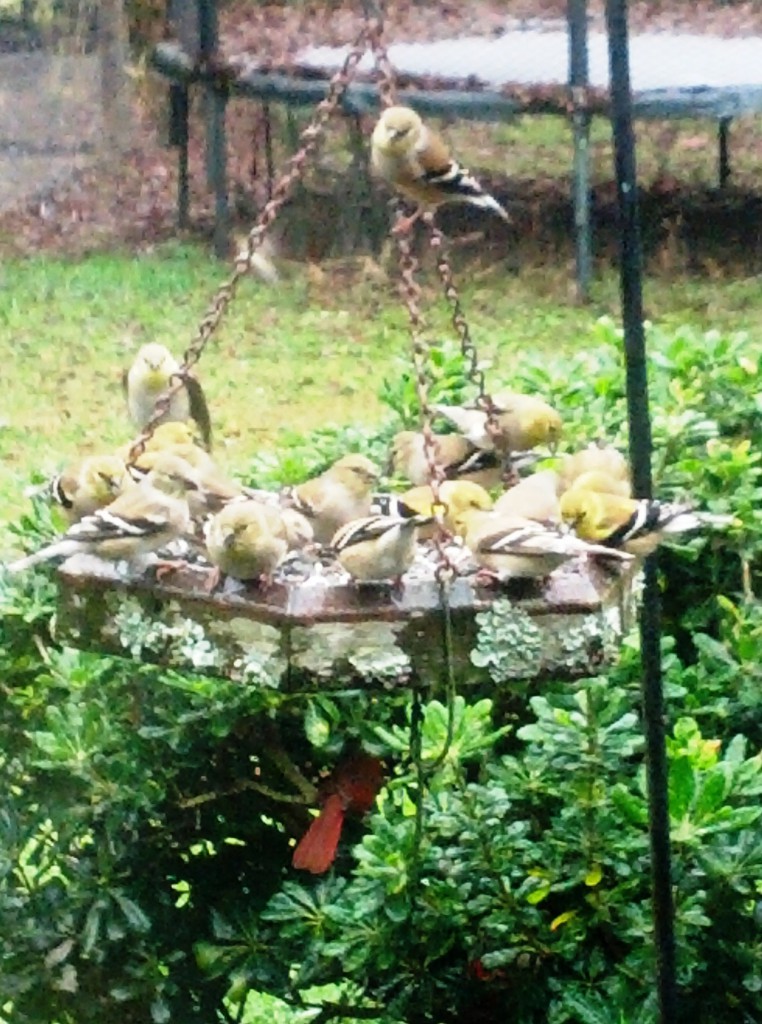
Do you see the red cardinal in the shrub? A variety of cover strategically placed near food sources helps minimize predation and provides protection from weather extremes. Photo by Judy Ludlow
When growing your backyard habitat, think about recreating features which are naturally provided in undisturbed habitats, but only on a smaller scale. To flourish, wildlife need adequate nutritious foods, functional cover, and clean water. Locating food close to cover minimizes the exposure of foraging wildlife to severe weather conditions and to predation; these two factors account for a large percentage of mortality. Cover comes in the form of trees, shrubs, brush piles, etc. of varying heights and sizes.
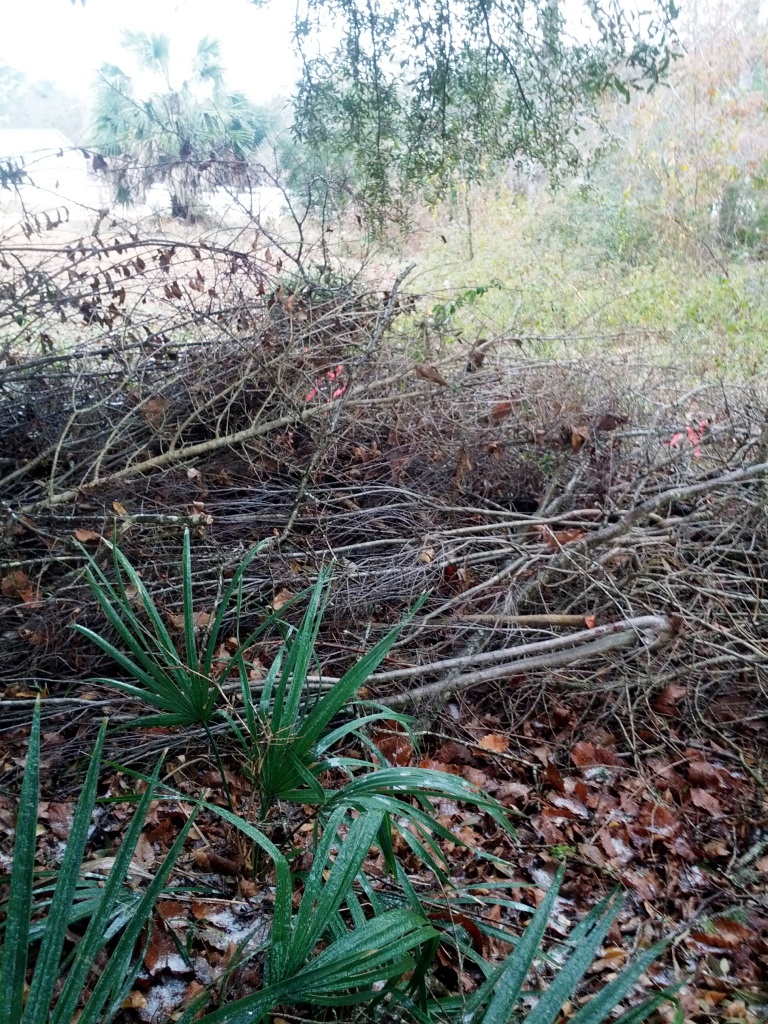
Brush piles such as this one provide valuable wildlife habitat for many species. Photo by Judy Ludlow
The following information is from the Florida Fish and Wildlife Conservation Commission’s publication: Planting a Refuge for Wildlife.
Cover: Breeding, nesting, hiding, sleeping, feeding and traveling are just a few of the necessary functions in an animal’s life which require protective cover or shelter. Often plants used for cover double as food sources. Strategic placement of cover is very important in that it reduces exposure to weather extremes and provides escape from predators.
Food: All animals get their energy for survival from plants or other animals. The ideal wildlife management plan uses natural vegetation to supply year-round food – from the earliest summer berries to fruits that persist through winter and spring (such as sweetgum, juniper and holly). You will attract the widest variety of wildlife to your land by using native plants to simulate small areas of nearby habitat types. The “edges” where these habitat types meet will probably be the most visited areas in your neighborhood.
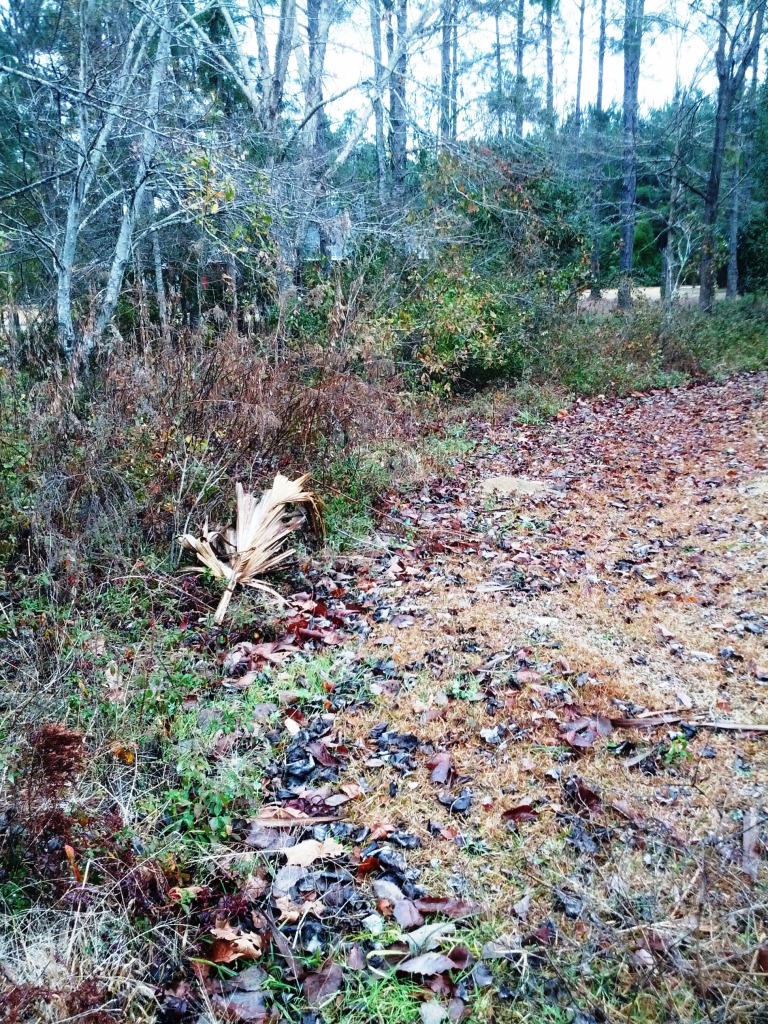
The boundary between two habitats such as between this lawn and small wooded area, creates an “edge effect” which is important to wildlife. Photo by Judy Ludlow
If you are interested in learning more about this topic, please read the following publications and, as always, please contact your local UF/IFAS Extension Agent if you have any questions.
Planting a Refuge for Wildlife
Landscaping for Wildlife
A Drop to Drink
Eight Ways to Double the Bird Species at Your Feeders
Landscaping for a Song
Making Your Backyard a Way Station for Migrants
On Your Own Turf
Plant Berry Producing Shrubs & Trees
Plant Wax Myrtles
There’s Life in Dead Trees
by Judy Biss | Jul 6, 2013
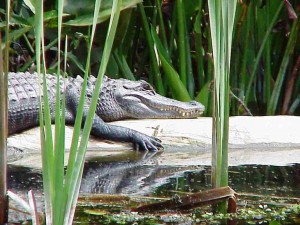
Summer is a time to bask in the sunshine for many of Florida’s wildlife species.
Each of Florida’s seasons are characterized by a variety of amazing and beautiful wildlife activities. Below is a list of some notable native wildlife behaviors occurring in July and August around the state.
July
Birds
- Shorebird migration starts in mid-July, peaking in August.
- Swallow-tailed kites begin gathering as do purple martins and tree swallows in preparation for migrating south for the winter.
- Look out for nesting shorebirds, and keep your vehicles and dogs from disturbing them.
Reptiles
- Later this month, young alligators and crocodiles will begin to hatch.
Mammals
- Baby raccoons, foxes, armadillos, possums, and bobcats leave dens and begin following parents.
Plants
- Sea oats flower along the Atlantic and Gulf.
- Scrub morning glory and butterfly weed begin to bloom.
Of Special Historical Note:
August
Birds
- First flocks of blue-winged and green-winged teal arrive to winter on Florida lakes and wetlands.
- Yellow warbler migration begins.
Mammals
- Two-year old black bear cubs will wean from their mothers.
- Short-tailed shrews will begin a second round of breeding for the year.
Reptiles
- Young sea turtles are hatching so avoid marked sea turtle nests and turn off lights to reduce light pollution.
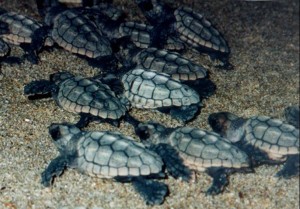
Sea turtle hatchlings are attracted to light sources on their dash to the ocean. Summer hatching means lights out for sea turtles! photo by L Avens 2003
Insects
- Thousands of great southern white butterflies can be seen migrating through coastal areas.
Invertebrates
- Corals along the Keys spawn at the full moon
More of these “happenings” for the calendar year can be found at the University of Florida’s Wildlife Extension Website: Wildlife Happenings.
Also at the Wildlife Extension website are a number of interesting resources to learn not only about our native wildlife, but our non-native/invasive wildlife as well. For example: can you distinguish between the invasive Cuban treefrog and our native species? The Cuban treefrog is well established in central and south Florida and has been documented in Bay and Leon Counties in north Florida. Be on the lookout for this alien treefrog!
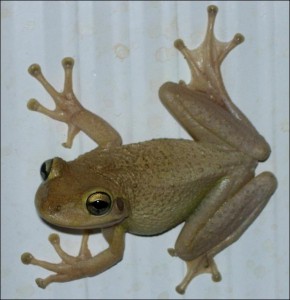
Natural habitats invaded by Cuban Treefrogs include pine forests, hardwood hammocks, and swamps. In urban and suburban settings they are most commonly found on and around homes and buildings, and in gardens and landscape plants – Image by Dr. Steve A Johnson 2005.
On the flip side, did you know that our “own” American Bullfrog is invasive in other countries throughout the world? Also, current research is investigating the observations that mating calls of some non-native frogs may interfere with the dynamics of native frogs’ calling behavior. These and other up-to-date facts can be found in the UF/IFAS Invader Updater newsletter. The current issue has articles on the suckermouth catfish, Cuban treefrog, lampreys, and the recent record-sized python caught in south Florida.
Focusing back to our own unique native wildlife, you may find, as I did, this UF website of Frogs & Toads of Florida of interest to you. It has beautiful pictures of each species as well as an audio recording of its distinctive call. So, turn up the volume on your speakers and listen to a sampling of the chorus that serenades Floridians each night. Click Here to listen to the call of the Squirrel Treefrog.
by Judy Biss | Apr 13, 2013
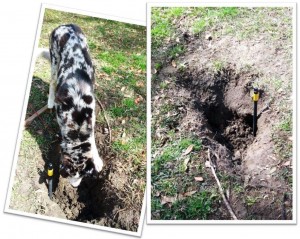
This tiny sinkhole appeared in my yard during the heavy March rains. Although only 3 feet wide, it was 5 feet deep. My dog looks both curious and jealous that it wasn’t one of the holes he’s dug!
During our heavy March rainfall events a tiny sinkhole appeared in my yard. While it was only 3 feet across, it was over 5 feet deep! After reading about the various types and causes of sinkholes, I decided it was most likely a “subsidence incident” sinkhole caused from collapsed underlying organic material (perhaps an old tree root?). Read on to learn more about sinkholes, their causes, and their prevalence in Florida.
Sinkholes are a fascinating, common, and sometimes tragic characteristic of Florida’s landscape. They are one feature of “karst” terrain which is quite prevalent in Florida. Other features of karst terrain include caves, springs, disappearing streams, and underground drainage systems. Karst terrain “is a type of topography that is formed by dissolution of bedrock in areas underlain by limestone, dolostone or, as in some western states, gypsum….The term karst, therefore, refers to the terrain and the term sinkhole is one of the types of drainage features reflected by that type of terrain. Other subterranean events can cause holes, depressions or subsidence of the land surface that may mimic sinkhole activity. These include subsurface expansive clay or organic layers which compress as water is removed, collapsed or broken sewer and drain pipes or broken septic tanks, improperly compacted soil after excavation work, and even buried trash, logs and other debris… Such an event is called a “subsidence incident.” (Source: Florida Dept of Environmental Protection http://dep.state.fl.us/geology/geologictopics/sinkhole.htm)
According to the United States Geological Survey and the Florida DEP Bureau of Geology, panhandle Florida’s limestone bedrock is overlain with from zero to over 200 feet of sediments. The depths and types of these overlying sediments are major factors in the prevalence and characteristics of sinkholes and other karst features. View this map to see an overview of sediment depth and sinkhole activity in your county. Leon County, in eastern panhandle Florida, boasts its geologically active Lake Jackson, not only for its famous largemouth bass fishery, but also for its periodic disappearances through underlying sinkholes! This 4,000 acre lake has a history of virtually draining through underlying sinkholes about every 25 years. Its most recent draining event was in 2006.
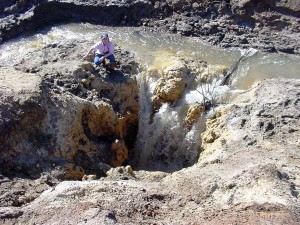
This is the sinkhole that drained Leon County’s Lake Jackson in 2006. The author is kneeling at its edge.
Please visit the following links for more information, including answers to questions such as:
- I think I have a sinkhole in my yard. What should I do?
- How do I fill in a sinkhole?
- Will watering our lawn lower the water table level and thus, cause sinkholes to develop in our neighborhood?
- Is there a government agency that will come and inspect my sinkhole?
- What is the sinkhole risk factor associated with my area?
- Is there a database showing all sinkholes in Florida?
- Our insurance company has informed us that the area where we are going to purchase property is listed as a sinkhole area. What does this mean? What can we do about it? Should we buy in that area?
Florida DEP, Bureau of Geology, All about Sinkholes, Questions and Answers.
Sinkhole Type, Development, and Distribution in Florida – A Map
UF/IFAS Disaster Handbook – Sinkholes
Sinkholes and Catastrophic Ground Collapse: What Every Floridian Should Know
by Judy Biss | Jan 9, 2013
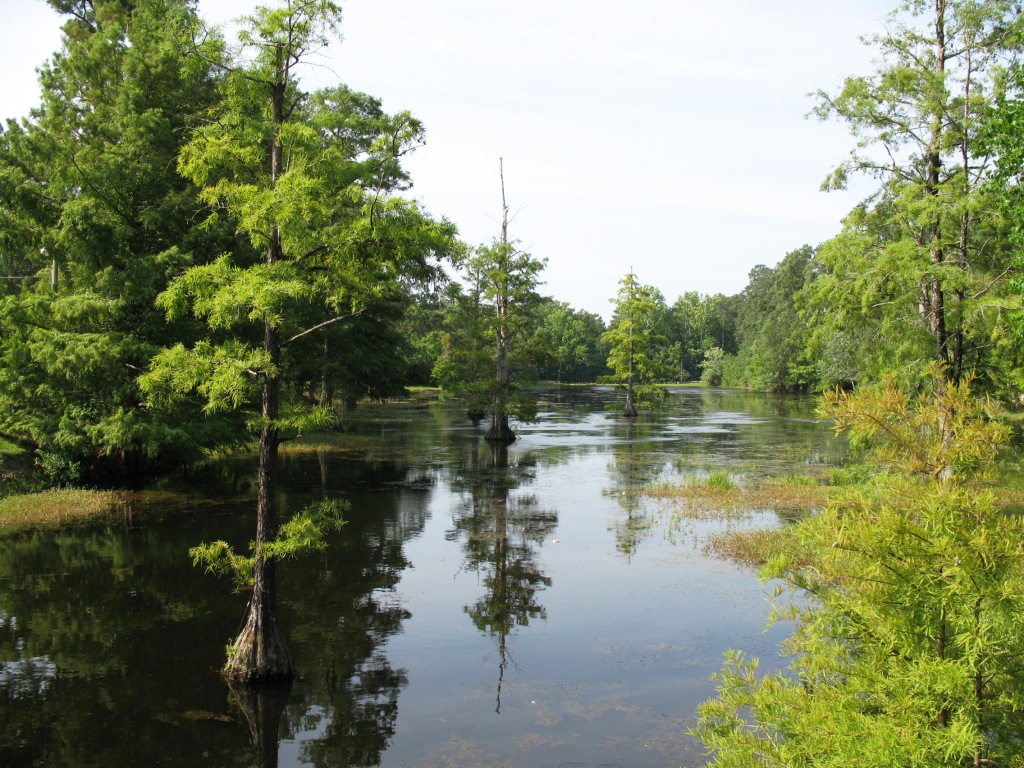
No matter our distance from a lake, wetland, river, or coastline, we all live within the boundaries of a watershed – photo by Judy Ludlow
No matter our distance from a lake, wetland, river, or coastline, we all live within the boundaries of a watershed. In fact, all land on earth is part of a watershed and all habitats exist within a watershed boundary. The size of watersheds can vary from a few square feet to millions of acres. It is important to realize our location is always within a watershed. All domestic, agricultural, horticultural, or industrial activities that occur in a specific watershed will impact surrounding water quality and quantity.
The United States Environmental Protection Agency defines a watershed as “an area of land where all of the water that is under it or drains off of it goes to a common waterway, such as a stream, lake, estuary, wetland, aquifer, or even the ocean.” Think of a watershed as a bowl or basin formed by the elevation of surrounding terrain. Gravity moves rainwater, surface water, and groundwater down the basin to its lowest point ending in a body of water.
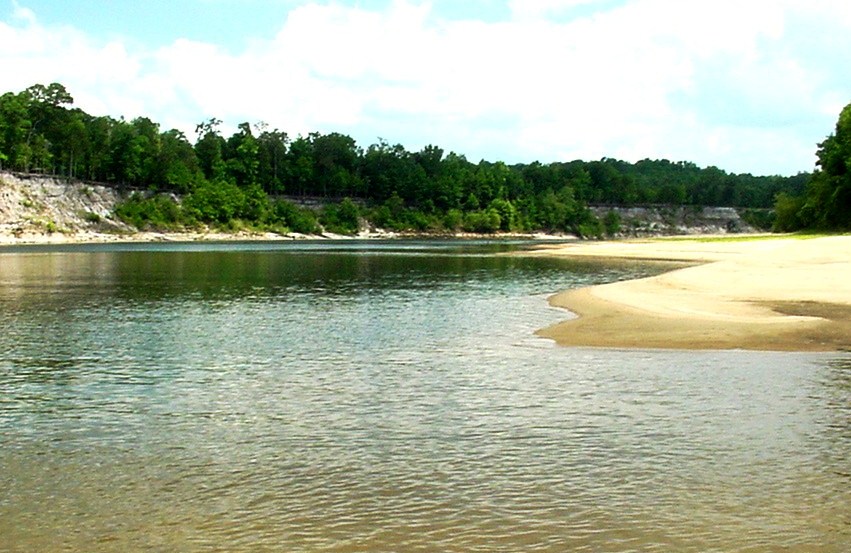
Being aware of your actions within the watershed is important to the long term water quality and quantity of your favorite panhandle Florida lake, river, or spring run – photo by Judy Ludlow
With that description in mind (water moving to the lowest point), think about the daily activities within your watershed. Watersheds contain houses, cars, businesses, natural areas, timber lands, agriculture, gardens, golf courses, shopping malls, pavement, septic systems, factories etc. So no matter where we are within our watershed, whatever falls to the ground (wash water, chemicals, fertilizers, fuels, oils, wastes, etc.) within that watershed will flow “downhill” to the water system that drains it. You may think the accidentally spilled motor oil may never reach the nearest lake, but it will impact the surface water and/or ground water as it moves downhill through the watershed. You may also think one isolated spill is insignificant. Keep in mind however; the more densely populated a watershed is, the greater the frequency and volume of impacts to surface and ground water will be.
Whether you are a business or individual, becoming aware of your watershed “address” is a novel way to view your essential connection to your water resources. Becoming aware, also, of your actions within the watershed, is important to the long term water quality and quantity of your favorite Panhandle lake, river, or spring run.
For more information about locating your watershed “address” and about watershed management please see the following resources.
Watersheds – Functions and Management
Find Your Watershed “Address”
Watersheds of Florida: Understanding a Watershed Approach to Water Management
Know Your Watershed














